Celtic Cross Spread
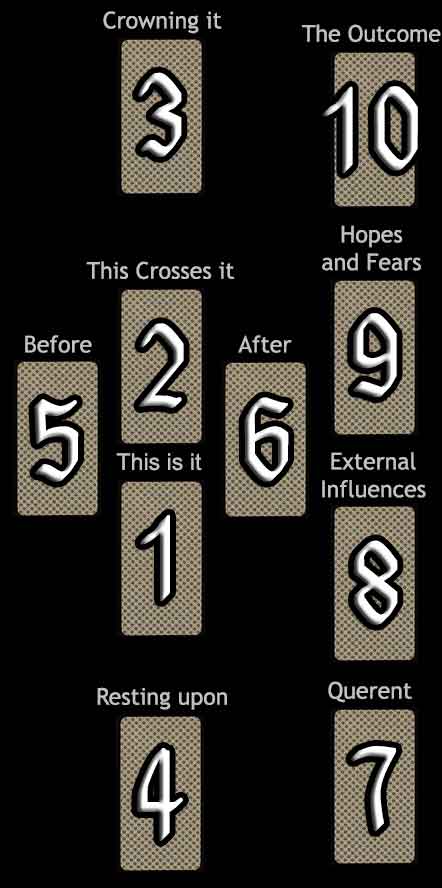
Difficulty: Average
This is probably the most well-known tarot spread. A good, basic spread for beginners to practise with, the Celtic Cross is useful for questions of all types. In this spread, it can be helpful to notice the relationships between the pairings of cards #5 & #9, #1 & #2, #3 & #4, and #6 & #10.
- The significator epitomizes what the reading deals with, the initial situation.
- An added impulse that compounds the significator, which may be either complimentary or contradictory.
- This is what is consciously known (thoughts).
- Unconscious driving forces that may not be known fully (emotions).
- The immediate past regarding the current situation.
- The first future card indicates the immediate future.
- This card represents the reader and their attitude towards cards #1 and #2.
- The external influences, the places and people which influence the topic.
- This tarot card suggests expectations; what is secretly hoped for or feared.
- The second future card reveals the long-term outcome.
Your Celtic Cross Reading
The Crown |
The Outcome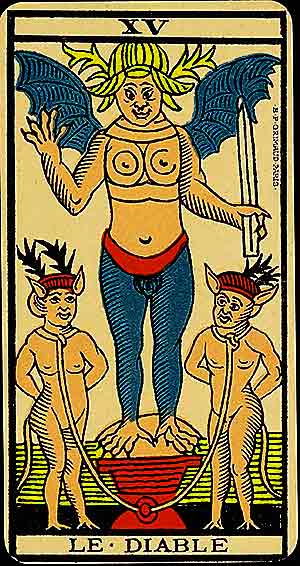 XV – The Devil (Le Diable)
External Forces 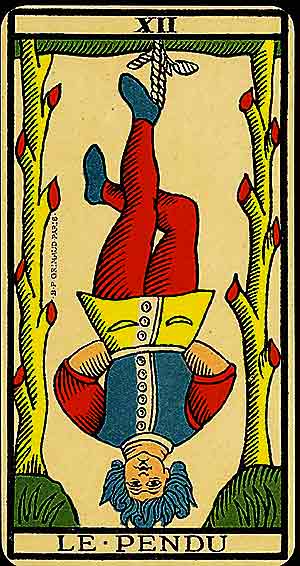 XII – The Hanged Man (Le Pendu)
|
||
The Recent Past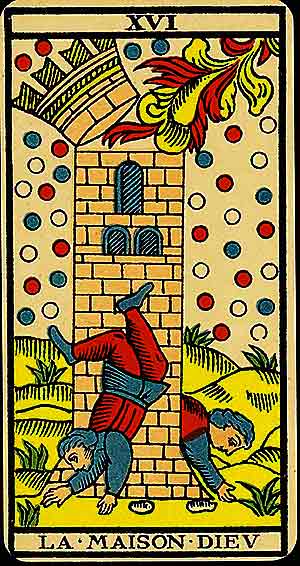 XVI – The Tower (La Maison Dieu) |
The Crossing Card
|
The Future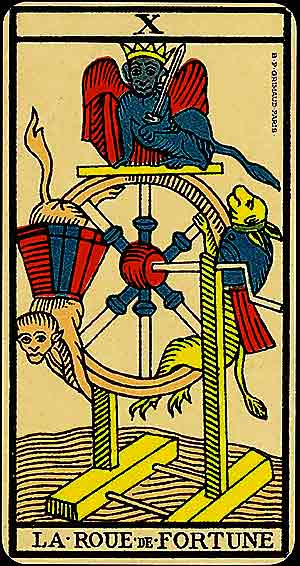 X – The Wheel of Fortune (La Roue de Fortune) |
|
|
|||
The Significator represents what the main theme of the reading deals with, the initial situation.
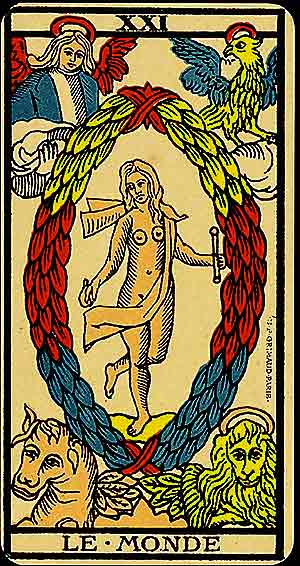
XXI – The World (Le Monde)
The World is the culmination of the journey, representing fulfilment, harmony, and unity. It signifies the integration of all aspects of life and the successful completion of a cycle, opening the way to new beginnings.
Symbolism: A central figure dances within a laurel wreath, symbolising victory and wholeness. The four corners often depict symbolic creatures (the lion, ox, eagle, and man), representing the elements, the fixed signs of the zodiac, or the four faces of a cherubim. The wreath signifies completion and eternity.
In Relationships: A harmonious, complete relationship or fulfilment of long-term goals in love. It reflects unity and shared purpose.
In Work: The successful culmination of a project or phase. Recognition and achievement mark this time of completion.
Spiritually: Le Monde invites the seeker to embrace the interconnectedness of all things, celebrating unity with the divine and readiness for new journeys.
When ill-dignified: Incompletion, stagnation, or feeling unfulfilled despite external success. It warns against losing sight of the bigger picture or resisting closure.
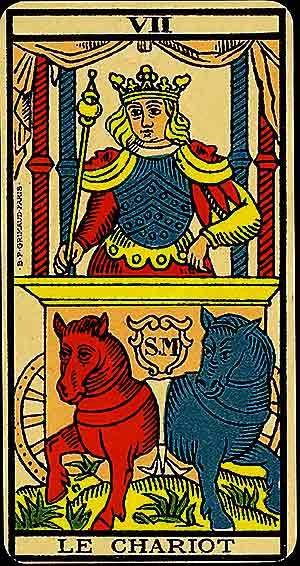
The Crossing Card denotes an added impulse that compounds the initial card, whether complimentary or contradictory.
VII – The Chariot
The Chariot represents triumph through willpower and discipline. It is the card of focused determination, suggesting the mastery of opposing forces to achieve a unified goal.
Symbolism: The charioteer stands tall, guiding two horses of contrasting colours, symbolising duality and control. The canopy above him evokes divine protection, while the wheels in motion reflect progress and momentum. His expression is resolute, embodying control amidst dynamic movement.
In Relationships: Moving forward together, overcoming challenges, or achieving harmony despite differences.
In Work: Success through focus, persistence, and strategic action. Victory is attainable through balance and self-control.
Spiritually: The Chariot teaches the alignment of inner and outer forces, calling for the integration of spirit and will to advance.
When ill-dignified: Lack of direction, recklessness, or internal conflict. It warns against being pulled in opposing directions without clarity of purpose.
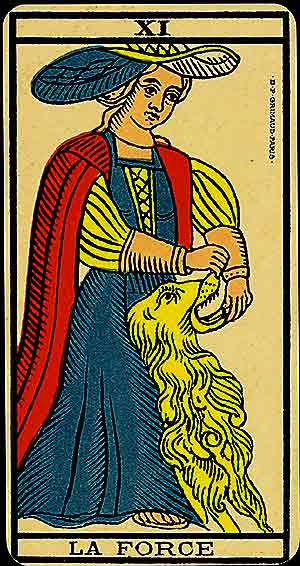
The Crown stands for what the asker is aware of consciously.
XI – Strength (La Force)
Strength symbolises the mastery of inner strength, courage, and the harmonisation of primal instincts with spiritual awareness. It teaches that true power lies in patience and understanding rather than brute force.
Symbolism: A figure calmly opens the jaws of a lion, symbolising the mental strength required to tame one's baser instincts. The figure's composed expression reflects confidence and inner control. The lion embodies raw energy and passion, while the gentle interaction suggests a balance between wildness and refinement.
In Relationships: Emotional resilience and understanding strengthen relationships. It may indicate a need for patience and compassion in matters of the heart.
In Work: Triumph through determination and calm perseverance. Success comes from maintaining focus and self-discipline.
Spiritually: Strength reflects the integration of instinct and higher consciousness, inviting you to connect with your inner power.
When ill-dignified: Impulsiveness, weakness, or unchecked aggression. It warns against letting fear or uncontrolled passions take the lead.
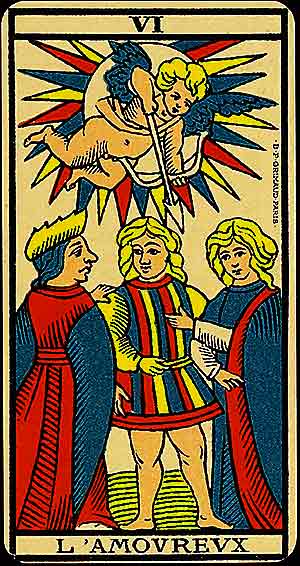
Foundation card reveals unconscious driving forces that the querent may not be aware of.
VI – The Lovers (L'Amoureux)
The Lovers signifies choice, connection, and the interplay between opposing forces. It represents the power of free will in aligning with one's deepest values and desires.
Symbolism: A central figure stands between two others, often interpreted as a choice between duty and desire or contrasting influences. Above, Cupid aims an arrow, symbolising divine inspiration or the fateful pull of love. The figures' expressions suggest conflict and harmony, reflecting the complexity of relationships.
In Relationships: Profound connections, romantic choices, or a pivotal decision within a partnership. It highlights emotional and spiritual harmony.
In Work: A crossroads where important decisions must align with personal values. Collaboration or partnerships may play a key role.
Spiritually: The Lovers calls for integrating dualities—earthly and divine, passion and reason—on the path to wholeness.
When ill-dignified: Indecision, temptation, or imbalance. It warns of superficial attractions or ignoring inner truth in key decisions.

The Recent Past represents past events and concerns.
XVI – The Tower (La Maison Dieu)
The Tower signifies sudden upheaval, revelation, and the destruction of false structures. It is a powerful reminder that chaos and doom often precede transformation and growth.
Symbolism: A tower struck by lightning blows its top as figures fall to the ground. The lightning represents divine intervention, while the tumbling balls and figures symbolise the collapse of illusions and false foundations. The falling crown signifies the downfall of pride. Despite its dramatic imagery, the card hints at liberation and renewal.
In Relationships: A dramatic change, often revealing truths that must be addressed.
In Work: Sudden challenges or shifts that dismantle old systems. It's a chance to rebuild on a stronger foundation.
Spiritually: The Tower urges the seeker to let go of illusions and embrace the profound truth revealed in moments of crisis.
When ill-dignified: Resistance to change, denial, or clinging to crumbling structures. It warns against ignoring the signs of impending transformation.

The Future depicts that which lies ahead.
VII – The Chariot
The Chariot represents triumph through willpower and discipline. It is the card of focused determination, suggesting the mastery of opposing forces to achieve a unified goal.
Symbolism: The charioteer stands tall, guiding two horses of contrasting colours, symbolising duality and control. The canopy above him evokes divine protection, while the wheels in motion reflect progress and momentum. His expression is resolute, embodying control amidst dynamic movement.
In Relationships: Moving forward together, overcoming challenges, or achieving harmony despite differences.
In Work: Success through focus, persistence, and strategic action. Victory is attainable through balance and self-control.
Spiritually: The Chariot teaches the alignment of inner and outer forces, calling for the integration of spirit and will to advance.
When ill-dignified: Lack of direction, recklessness, or internal conflict. It warns against being pulled in opposing directions without clarity of purpose.
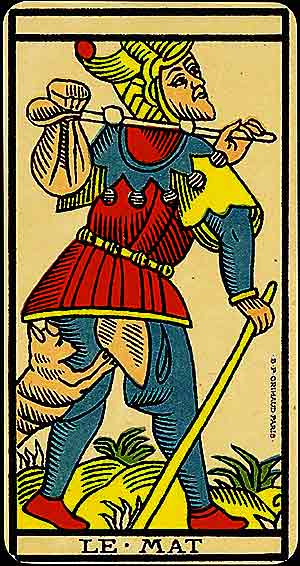
The Querent represents the asker and their attitude towards the subject of the reading.
0 – The Fool (Le Mat)
The Fool represents the untamed spirit and unshackled freedom of the soul. He wanders without boundaries, embodying movement, exploration, and detachment from worldly concerns. This card invites us to embrace change and unpredictability with courage and spontaneity.
Symbolism: The dog biting at the Fool's leg symbolises the tension between freedom and earthly constraints. His staff and bundle represent the burdens and wisdom accumulated on life's journey, carried with both carelessness and purpose. The colourful jester's attire signifies his eccentricity and adaptability, while his forward gaze reflects an openness to the unknown.
In Relationships: A new, unpredictable connection or the need for more spontaneity in existing relationships. Beware of recklessness.
In Work: Embarking on a risky or unconventional path, where intuition takes precedence over plans.
Spiritually: The Fool embodies the soul's leap into the vast unknown, trusting the divine order of chaos.
When ill-dignified: Naivety, poor judgement, or a lack of grounding. It warns of becoming aimless or distracted by superficial pursuits.

External Forces represents the influence of others in your life as well as trends in your relationships with others.
XII – The Hanged Man (Le Pendu)
The Hanged Man represents surrender, perspective, and the wisdom gained through sacrifice. It signifies the pause required for deeper insight and the willingness to let go of attachments to achieve spiritual growth.
Symbolism: A figure hangs upside down from a grafted tree, forming an almost serene cross-like posture. The inversion suggests seeing the world from a different perspective, while the living tree structure reflects the connection to spiritual growth. His tranquil expression emphasises acceptance and enlightenment through suspension.
In Relationships: A need for patience, reflection, or a fresh perspective on a relationship. It can also suggest letting go of control.
In Work: A time to pause, reassess, and allow things to unfold. Solutions may come from viewing challenges differently.
Spiritually: The Hanged Man invites the seeker to embrace surrender as a path to awakening and profound understanding.
When ill-dignified: Stubbornness, resistance to change, or avoiding necessary sacrifices. It warns against remaining stuck in unproductive situations.

Hopes and Fears shows the expectations you have concerning the outcome of your question.
XIII – Death (La Mort)
Death signifies transformation, endings, and renewal. While often feared, this card speaks to the cyclical nature of life and the necessity of clearing away the old to make way for the new.
Symbolism: A skeletal figure wields a scythe, cutting through the remnants of the past—hands, heads, and plants alike. The barren ground reflects the stripping away of what no longer serves, while the sprouting flowers hint at rebirth and growth emerging from decay.
In Relationships: The end of a relationship or a transformative phase within one. It signals profound changes, often for the better.
In Work: A major shift, such as the end of a job or the restructuring of goals. It's a call to embrace new opportunities.
Spiritually: Death teaches the power of release and the necessity of embracing life's cycles to achieve transformation.
When ill-dignified: Fear of change, stagnation, or clinging to the past. It warns against resisting the natural process of renewal.

The Outcome of your question. Interpret this card in the context of the entire reading and as an indicator of the path you are currently on, but not necessarily bound to.
XV – The Devil (Le Diable)
The Devil represents temptation, materialism, and the power of the shadow self. While it warns of unhealthy attachments, it also offers an opportunity to confront and integrate the darker aspects of human nature.
Symbolism: A horned figure dominates the scene, with two smaller chained figures below, symbolising bondage to desires or fears. The loose chains suggest that this bondage is self-imposed and can be escaped. The card's imagery reflects both the allure and consequences of indulgence.
In Relationships: Obsessive or co-dependent relationships. It may indicate intense passion or unhealthy dynamics.
In Work: Temptation to take shortcuts or pursue goals at the expense of ethics. A need to reassess priorities.
Spiritually: The Devil challenges you to confront your shadow self and transform fears into liberation.
When ill-dignified: Escapism, addiction, or manipulative behaviours. It warns of being trapped in destructive patterns.